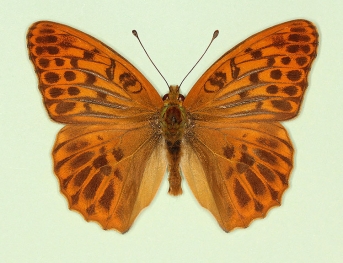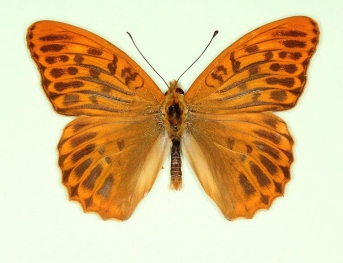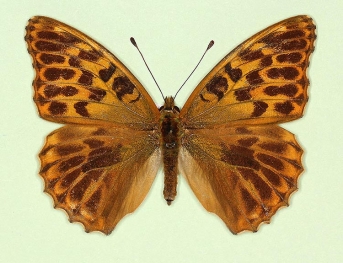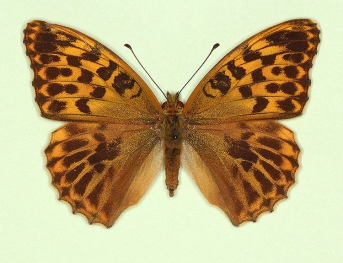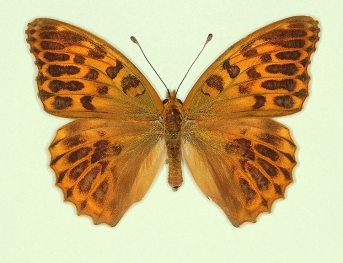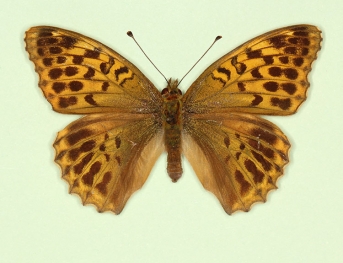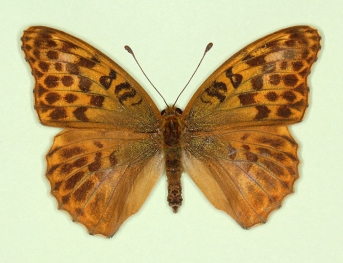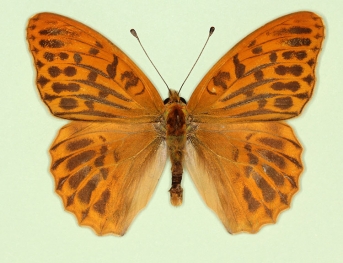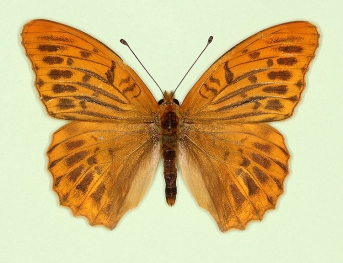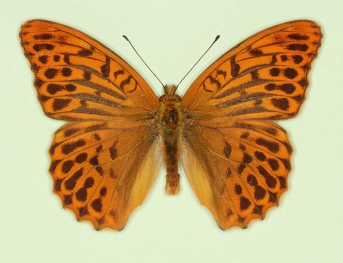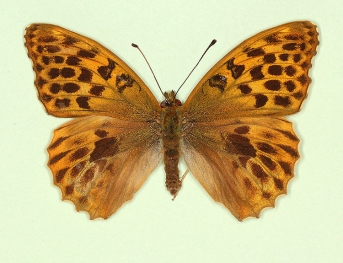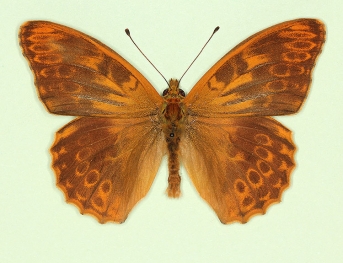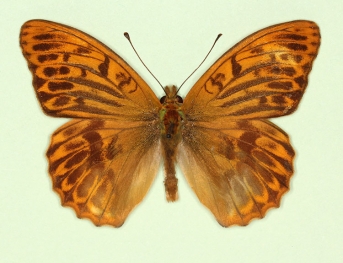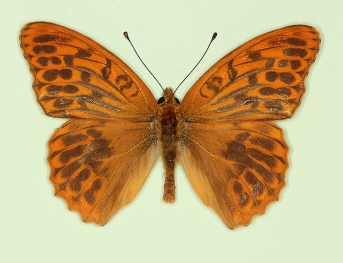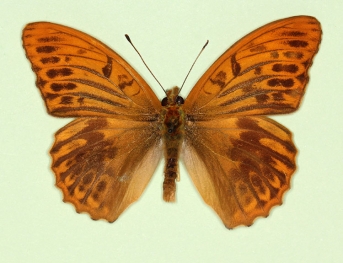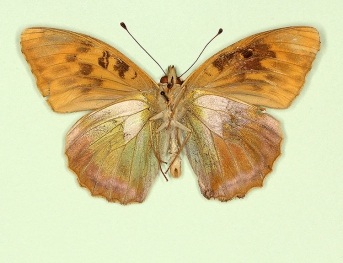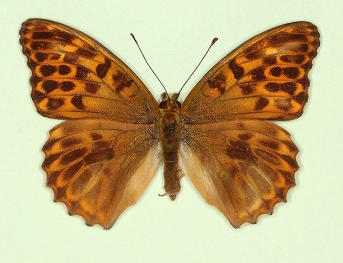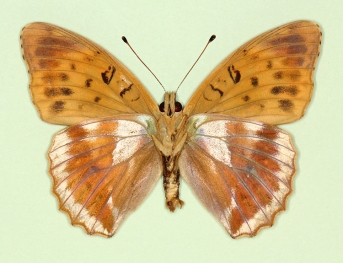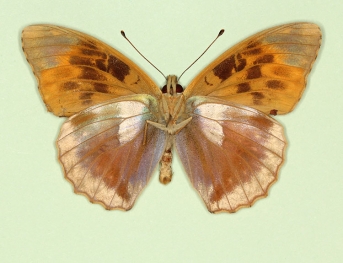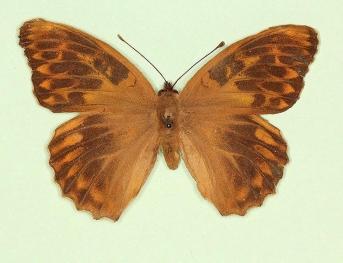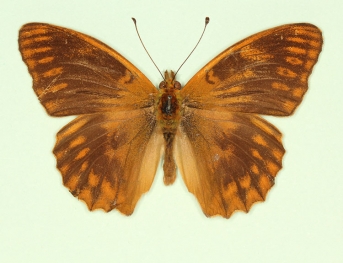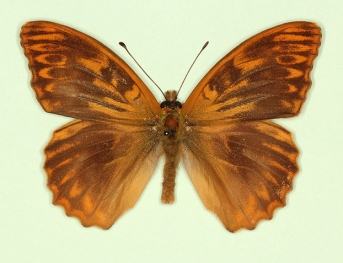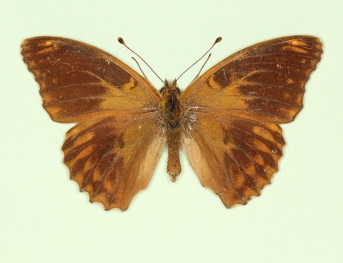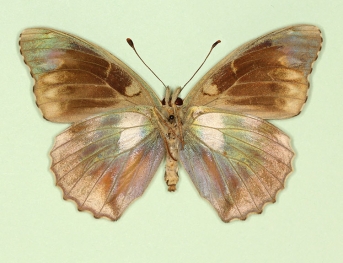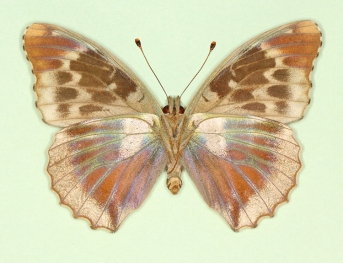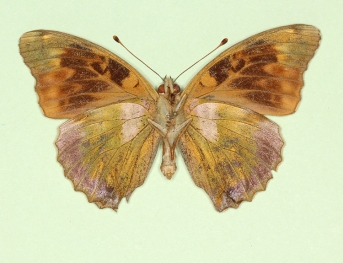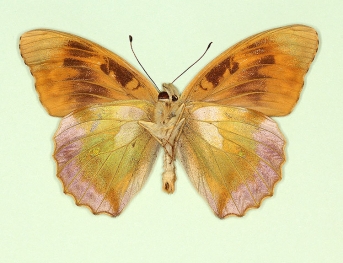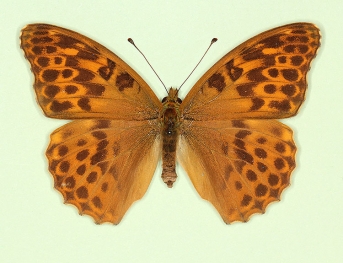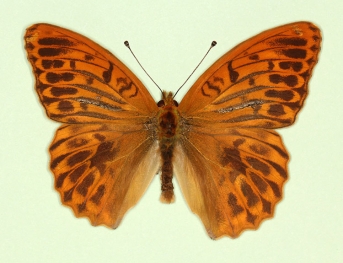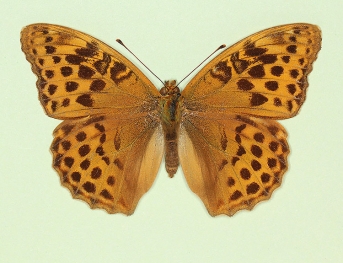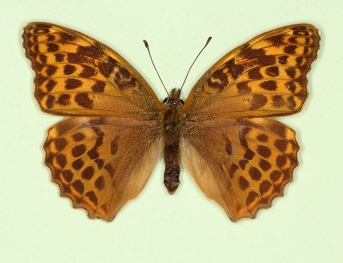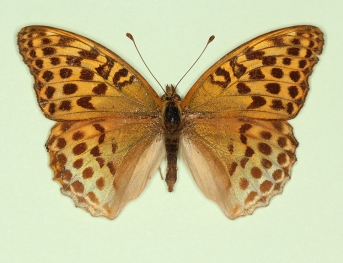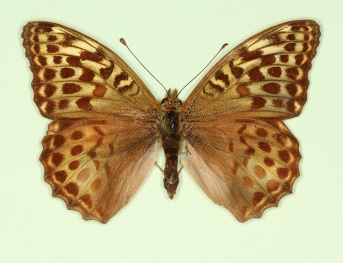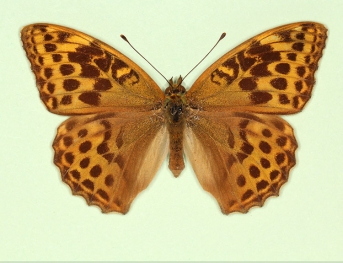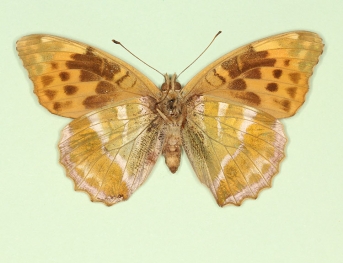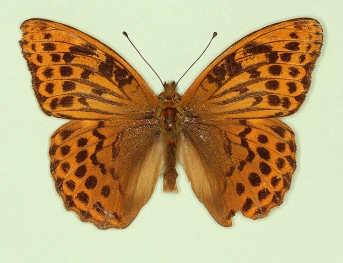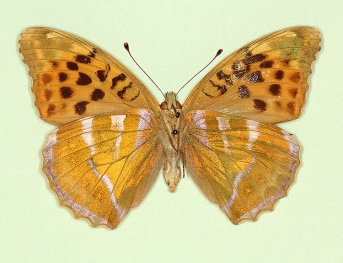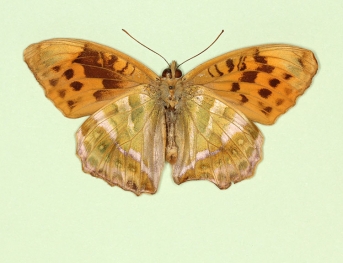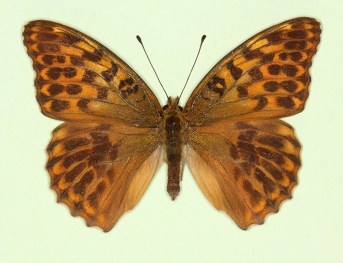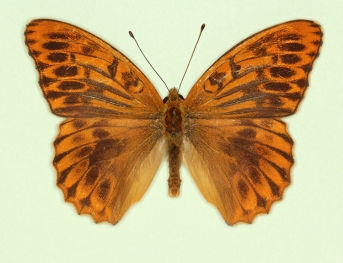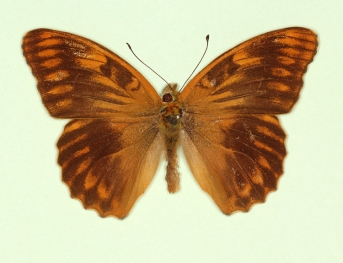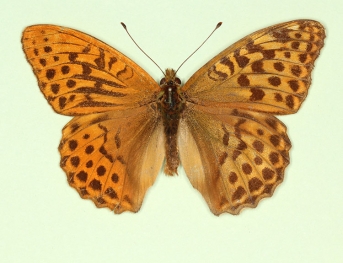Silver-washed Fritillary Argynnis paphia
A relatively common species throughout southern woodlands.
Silver-washed Fritillary Argynnis paphia - typical recto

typical recto
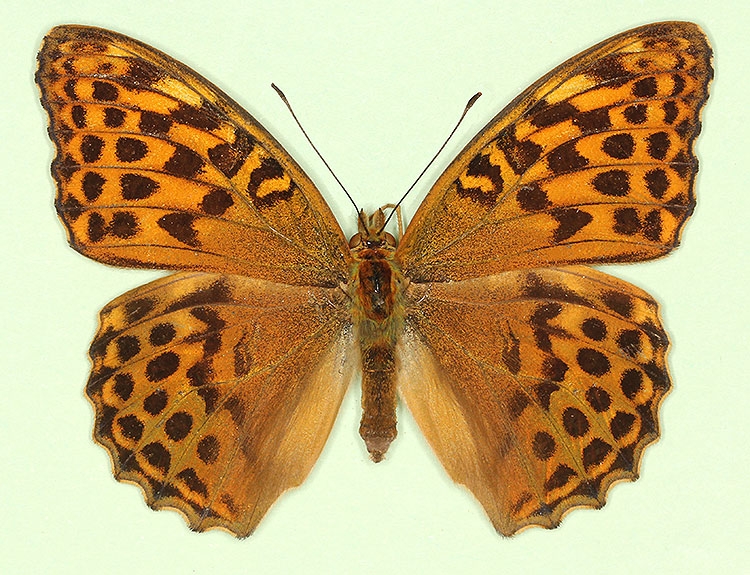
Silver-washed Fritillary Argynnis paphia - typical verso

typical verso
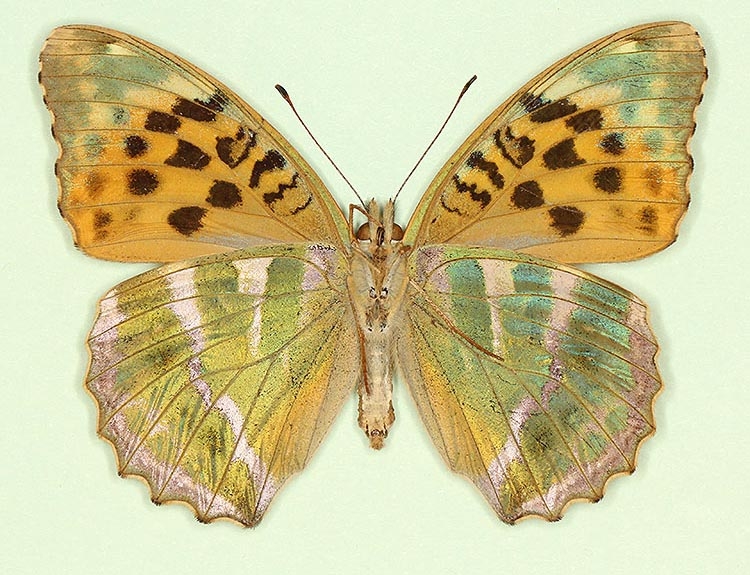
Silver-washed Fritillary Argynnis paphia - typical recto

typical recto
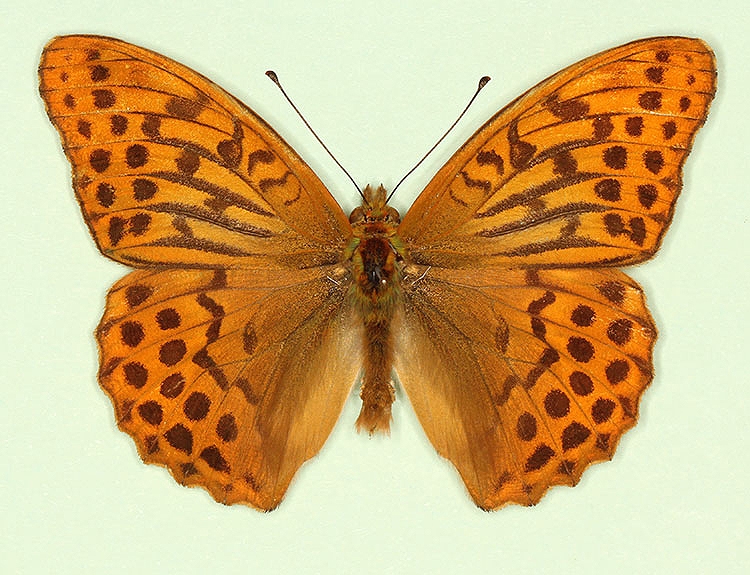
Silver-washed Fritillary Argynnis paphia - typical verso

typical verso
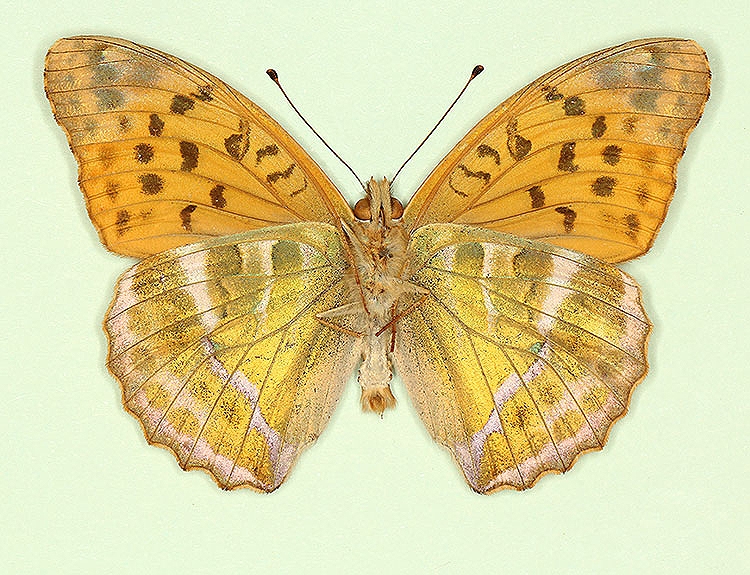
Aberrations
Click on any of the images to view a larger image and comparison specimen.
Silver-washed Fritillary Argynnis paphia - confluens

typical recto

ab. confluens Spuler 1901
Upperside with the two outer rows of black spots united with each other to form marginal rays.
Silver-washed Fritillary Argynnis paphia - confluens

typical recto

ab. confluens Spuler 1901
Upperside with the two outer rows of black spots united with each other to form marginal rays.
Silver-washed Fritillary Argynnis paphia - confluens

typical recto

ab. confluens Spuler 1901
Upperside with the two outer rows of black spots united with each other to form marginal rays.
Silver-washed Fritillary Argynnis paphia - confluens

typical recto

ab. confluens Spuler 1901
Upperside with the two outer rows of black spots united with each other to form marginal rays.
Silver-washed Fritillary Argynnis paphia - confluens

typical recto

ab. confluens Spuler 1901
Upperside with the two outer rows of black spots united with each other to form marginal rays.
Silver-washed Fritillary Argynnis paphia - confluens

typical recto

ab. confluens Spuler 1901
Upperside with the two outer rows of black spots united with each other to form marginal rays.
Silver-washed Fritillary Argynnis paphia - confluens

typical recto

ab. confluens Spuler 1901
Upperside with the two outer rows of black spots united with each other to form marginal rays.
Silver-washed Fritillary Argynnis paphia - confluens

typical recto

ab. confluens Spuler 1901
Upperside with the two outer rows of black spots united with each other to form marginal rays.
Silver-washed Fritillary Argynnis paphia - confluens

typical recto

ab. confluens Spuler 1901
Upperside with the two outer rows of black spots united with each other to form marginal rays.
Silver-washed Fritillary Argynnis paphia - confluens

typical recto

ab. confluens Spuler 1901
Upperside with the two outer rows of black spots united with each other to form marginal rays.
Silver-washed Fritillary Argynnis paphia - post-confluens

typical recto

Post ab. confluens Spuler 1901
Upperside with the two outer rows of black spots united with each other to form marginal rays.
On this specimen it only applies to the hindwings.
Silver-washed Fritillary Argynnis paphia - pelopioides

typical recto

ab. pelopioides Krombach 1916
This is similar to the following ab. ocellata.
Forewings with the black area increased from the median row of spots outwards towards so that ovals of ground colour remain before the margins, each enclosing a black spot and appearing like two rows of eyes or ocelli.
Hindwings with the basal half of normal ground colour with the outer half being black, except for longish ovals of ground colour in which the two rows of black spots are enclosed, two spots in each oval.
In ab. ocellata these two spots are fused into one large patch.
Silver-washed Fritillary Argynnis paphia - ocellata

typical recto

ab. ocellata Frings 1902
The upperside of the wings have striking longitudinal spots enclosed in one ring of ground colour before the margins which appear like a row of eye spots and caused by the union, or fusion of the two rows of black spots before the margin.
More simply the aberration is characterised by the broadening and flowing out of the black markings of the central areas which may vary in intensity.
Silver-washed Fritillary Argynnis paphia - ocellata

typical recto

ab. ocellata Frings 1902
The upperside of the wings have striking longitudinal spots enclosed in one ring of ground colour before the margins which appear like a row of eye spots and caused by the union, or fusion of the two rows of black spots before the margin.
More simply the aberration is characterised by the broadening and flowing out of the black markings of the central areas which may vary in intensity.
Silver-washed Fritillary Argynnis paphia - ocellata

typical recto

ab. ocellata Frings 1902
The upperside of the wings have striking longitudinal spots enclosed in one ring of ground colour before the margins which appear like a row of eye spots and caused by the union, or fusion of the two rows of black spots before the margin.
More simply the aberration is characterised by the broadening and flowing out of the black markings of the central areas which may vary in intensity.
Silver-washed Fritillary Argynnis paphia - ocellata

typical verso

ab. ocellata Frings 1902
The upperside of the wings have striking longitudinal spots enclosed in one ring of ground colour before the margins which appear like a row of eye spots and caused by the union, or fusion of the two rows of black spots before the margin.
More simply the aberration is characterised by the broadening and flowing out of the black markings of the central areas which may vary in intensity.
Silver-washed Fritillary Argynnis paphia - ocellata

typical recto

ab. ocellata Frings 1902
The upperside of the wings have striking longitudinal spots enclosed in one ring of ground colour before the margins which appear like a row of eye spots and caused by the union, or fusion of the two rows of black spots before the margin.
More simply the aberration is characterised by the broadening and flowing out of the black markings of the central areas which may vary in intensity.
Silver-washed Fritillary Argynnis paphia - ocellata

typical verso

ab. ocellata Frings 1902
The upperside of the wings have striking longitudinal spots enclosed in one ring of ground colour before the margins which appear like a row of eye spots and caused by the union, or fusion of the two rows of black spots before the margin.
More simply the aberration is characterised by the broadening and flowing out of the black markings of the central areas which may vary in intensity.
Silver-washed Fritillary Argynnis paphia - ocellata

typical verso

ab. ocellata Frings 1902
The upperside of the wings have striking longitudinal spots enclosed in one ring of ground colour before the margins which appear like a row of eye spots and caused by the union, or fusion of the two rows of black spots before the margin.
More simply the aberration is characterised by the broadening and flowing out of the black markings of the central areas which may vary in intensity.
Silver-washed Fritillary Argynnis paphia - ocellata

typical recto

ab. ocellata Frings 1902
The upperside of the wings have striking longitudinal spots enclosed in one ring of ground colour before the margins which appear like a row of eye spots and caused by the union, or fusion of the two rows of black spots before the margin.
More simply the aberration is characterised by the broadening and flowing out of the black markings of the central areas which may vary in intensity.
Silver-washed Fritillary Argynnis paphia - sylvia

typical recto

ab. sylvia Fischer 1914
very similar to ab. nigricans.
The upperside of all wings are uniformly black except for the base and a very narrow marginal band 1mm in breadth, and two or three intercostal streaks of brown in the apical area.
Silver-washed Fritillary Argynnis paphia - sylvia

typical recto

ab. sylvia Fischer 1914
very similar to ab. nigricans.
The upperside of all wings are uniformly black except for the base and a very narrow marginal band 1mm in breadth, and two or three intercostal streaks of brown in the apical area.
Silver-washed Fritillary Argynnis paphia - nigricans

typical recto

ab. nigricans Cosmovici 1892
This is a very variable aberration, and produces some very striking specimens.
The original description by Cosmovici is rather vague and lacking in detail.
The fore and hindwings are black as far as the marginal spots which touch themselves. This description probably means that the two rows of spots are fused together, with the black area giving the appearance of a practically black wing with lighter spaces in the margins so that the fused spots can still be seen.
Silver-washed Fritillary Argynnis paphia - nigricans

typical verso

ab. nigricans Cosmovici 1892
This is a very variable aberration, and produces some very striking specimens.
The original description by Cosmovici is rather vague and lacking in detail and applies to the recto surface. This is an underside.
The fore and hindwings are black as far as the marginal spots which touch themselves. This description probably means that the two rows of spots are fused together, with the black area giving the appearance of a practically black wing with lighter spaces in the margins so that the fused spots can still be seen.
Silver-washed Fritillary Argynnis paphia - nigricans

typical verso

ab. nigricans Cosmovici 1892
This is a very variable aberration, and produces some very striking specimens.
The original description by Cosmovici is rather vague and lacking in detail and applies to the recto surface. This is an underside.
The fore and hindwings are black as far as the marginal spots which touch themselves. This description probably means that the two rows of spots are fused together, with the black area giving the appearance of a practically black wing with lighter spaces in the margins so that the fused spots can still be seen.
Silver-washed Fritillary Argynnis paphia - nigricans

typical verso

ab. nigricans Cosmovici 1892
This is a very variable aberration, and produces some very striking specimens.
The original description by Cosmovici is rather vague and lacking in detail and applies to the recto surface. This is an underside.
The fore and hindwings are black as far as the marginal spots which touch themselves. This description probably means that the two rows of spots are fused together, with the black area giving the appearance of a practically black wing with lighter spaces in the margins so that the fused spots can still be seen.
Silver-washed Fritillary Argynnis paphia - nigricans

typical verso

ab. nigricans Cosmovici 1892
This is a very variable aberration, and produces some very striking specimens.
The original description by Cosmovici is rather vague and lacking in detail and applies to the recto surface. This is an underside.
The fore and hindwings are black as far as the marginal spots which touch themselves. This description probably means that the two rows of spots are fused together, with the black area giving the appearance of a practically black wing with lighter spaces in the margins so that the fused spots can still be seen.
Silver-washed Fritillary Argynnis paphia - transversa

typical recto

ab. transversa Lempke 1956
The upperside forewing median spots are enlarged and coalescent so as to form a continuous zig-zag band, The spots of the hind wing are enlarged
Silver-washed Fritillary Argynnis paphia - confluens

typical recto

Silver-washed Fritillary Argynnis paphia - nov

typical recto

Silver-washed Fritillary Argynnis paphia - nov

typical recto

Silver-washed Fritillary Argynnis paphia - nov

typical recto

Silver-washed Fritillary Argynnis paphia - nov

typical recto

Silver-washed Fritillary Argynnis paphia - nov

typical recto

Silver-washed Fritillary Argynnis paphia - nov

typical verso

Silver-washed Fritillary Argynnis paphia - nov

typical recto

Silver-washed Fritillary Argynnis paphia - asymmetrical

typical verso

Silver-washed Fritillary Argynnis paphia - asymmetrical

typical verso

Silver-washed Fritillary Argynnis paphia - ocellata

typical recto

Silver-washed Fritillary Argynnis paphia - ocellata

typical recto

Silver-washed Fritillary Argynnis paphia - ocellata

typical recto

Silver-washed Fritillary Argynnis paphia - Bilateral gynandromorph

typical recto

